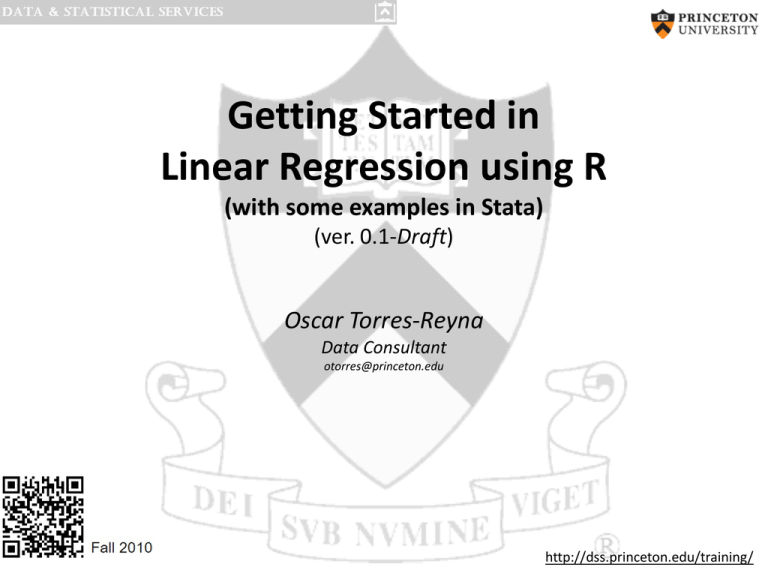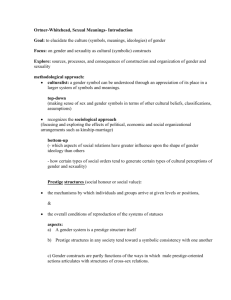
Getting Started in
Linear Regression using R
(with some examples in Stata)
(ver. 0.1-Draft)
Oscar Torres-Reyna
Data Consultant
otorres@princeton.edu
http://dss.princeton.edu/training/
R
Stata
Using dataset “Prestige”*
Used in the regression models in the following pages
# Dataset is in the following library
/* Stata version here */
library(car)
use http://www.ats.ucla.edu/stat/stata/examples/ara/Prestige, clear
# If not installed type
/* Renaming/recoding variables to match the
dataset’s R version*/
install.packages("car")
# Type help(Prestige) to access the codebook
education. Average education of occupational
incumbents, years, in 1971.
income. Average income of incumbents, dollars, in
1971.
women. Percentage of incumbents who are women.
prestige. Pineo-Porter prestige score for occupation,
from a social survey conducted in the mid-1960s.
census .Canadian Census occupational code.
rename educat education
rename percwomn women
rename occ_code census
recode occ_type (2=1 "bc")(4=2 "wc")(3=3
"prof")(else=.), gen(type) label(type)
label variable type "Type of occupation"
drop occ_type
replace type=3 if occtitle=="PILOTS"
gen log2income=log10(income)/log10(2)
type. Type of occupation. A factor with levels (note:
out of order): bc, Blue Collar; prof, Professional,
Managerial, and Technical; wc, White Collar.
*Fox, J. and Weisberg, S. (2011) An R Companion to Applied Regression, Second Edition, Sage.
NOTE: The R content presented in this document is mostly based on an early version of Fox, J. and Weisberg, S. (2011) An
R Companion to Applied Regression, Second Edition, Sage; and from class notes from the ICPSR’s workshop Introduction
to the R Statistical Computing Environment taught by John Fox during the summer of 2010.
2
Linear regression (heteroskedasticity-robust standard errors)
library(lmtest)
library(sandwich)
reg1$robse <- vcovHC(reg1, type="HC1")
coeftest(reg1,reg1$robse)
For cluster standard errors see the slide towards the end of this document.
regress prestige education log2income women,
robust
R
Stata
Linear regression (output)
. regress prestige education log2income women
Source
SS
df
MS
Model
Residual
24965.5409
4929.88524
3
98
8321.84695
50.3049514
Total
29895.4261
101
295.994318
prestige
Coef.
education
log2income
women
_cons
3.730508
9.314667
.0468951
-110.9658
Std. Err.
.354383
1.326515
.0298989
14.84293
t
10.53
7.02
1.57
-7.48
Number of obs
F( 3,
98)
Prob > F
R-squared
Adj R-squared
Root MSE
P>|t|
0.000
0.000
0.120
0.000
=
=
=
=
=
=
102
165.43
0.0000
0.8351
0.8300
7.0926
[95% Conf. Interval]
3.027246
6.682241
-.0124382
-140.4211
4.433769
11.94709
.1062285
-81.51052
4
NOTE: For output interpretation (linear regression) please see http://dss.princeton.edu/training/Regression101.pdf
R
Stata
Dummy regression with no interactions (analysis of covariance, fixed effects)
reg2 <- lm(prestige ~ education + log2(income) +
type, data = Prestige)
summary(reg2)
Stata 11.x*
regress prestige education log2income
i.type
Stata 10.x
(See output next page)
xi: regress prestige education log2income
# Reordering factor variables
Prestige$type <- with(Prestige, factor(type,
levels=c("bc", "wc", "prof")))
i.type
*See http://www.stata.com/help.cgi?whatsnew10to11
Dummy regression with no interactions (interpretation, see output next page)
bc
wc
prof
Intercept
-81.2
-81.2-1.44 = -82.64
-81.2 + 6.75 = -74.45
log2(income)
7.27
7.27
7.27
education
3.28
3.28
3.28
NOTE: “type” is a categorical or factor variable with three options: bc (blue collar), prof (professional, managerial, and
technical) and wc (white collar). R automatically recognizes it as factor and treat it accordingly. In Stata you need
to identify it with the “i.” prefix (in Stata 10.x or older you need to add “xi:”)
NOTE: For output interpretation (linear regression) please see http://dss.princeton.edu/training/Regression101.pdf
NOTE: For output interpretation (fixed effects) please see http://dss.princeton.edu/training/Panel101.pdf
5
R
Stata
Dummy regression with interactions (output)
. regress prestige education log2income
Source
SS
df
i.type
MS
Model
Residual
24250.5893
4096.2858
4
93
6062.64731
44.0460839
Total
28346.8751
97
292.235825
prestige
Coef.
Std. Err.
education
log2income
3.284486
7.269361
.608097
1.189955
type
2
3
-1.439403
6.750887
_cons
-81.20187
t
Number of obs
F( 4,
93)
Prob > F
R-squared
Adj R-squared
Root MSE
=
=
=
=
=
=
98
137.64
0.0000
0.8555
0.8493
6.6367
P>|t|
[95% Conf. Interval]
5.40
6.11
0.000
0.000
2.076926
4.906346
4.492046
9.632376
2.377997
3.618496
-0.61
1.87
0.546
0.065
-6.161635
-.434729
3.282828
13.9365
13.74306
-5.91
0.000
-108.4929
-53.91087
6
R
Stata
Dummy regression with interactions
reg3 <- lm(prestige ~ type*(education +
log2(income)), data = Prestige)
summary(reg3)
(See output next page)
Stata 11.x*
regress prestige i.type##c.education
i.type##c.log2income
Stata 10.x
# Other ways to run the same model
reg3a <- lm(prestige ~ education + log2(income) +
type + log2(income):type + education:type,
data = Prestige)
xi: regress prestige i.type*education
i.type*log2income
*See http://www.stata.com/help.cgi?whatsnew10to11
reg3b <- lm(prestige ~ education*type +
log2(income)*type, data = Prestige)
Dummy regression with interactions (interpretation, see output next page)
Intercept
bc
wc
prof
-120.05
-120.05 +30.24 = -89.81
-120.05 + 85.16 = -34.89
log2(income)
11.08
11.08-5.653 = 5.425
11.08 - 6.536 = 4.542
education
2.34
2.34 + 3.64 = 5.98
2.34 + 0.697 = 3.037
NOTE: “type” is a categorical or factor variable with three options: bc (blue collar), prof (professional, managerial, and
technical) and wc (white collar). R automatically recognizes it as factor and treat it accordingly. In Stata you need
to identify it with the “i.” prefix (in Stata 10.x or older you need to add “xi:”)
7
NOTE: For output interpretation (linear regression) please see http://dss.princeton.edu/training/Regression101.pdf
NOTE: For output interpretation (fixed effects) please see http://dss.princeton.edu/training/Panel101.pdf
R
Stata
Dummy regression with interactions (output)
. regress prestige i.type##c.education i.type##c.log2income
Source
SS
df
MS
Model
Residual
24691.4782
3655.3969
8
89
3086.43477
41.0718753
Total
28346.8751
97
292.235825
P>|t|
98
75.15
0.0000
0.8710
0.8595
6.4087
Coef.
type
2
3
30.24117
85.16011
37.97878
31.181
0.80
2.73
0.428
0.008
-45.22186
23.20414
105.7042
147.1161
education
2.335673
.927729
2.52
0.014
.492295
4.179051
type#
c.education
2
3
3.640038
.6973987
1.758948
1.289508
2.07
0.54
0.041
0.590
.1450456
-1.864827
7.13503
3.259624
log2income
11.07821
1.806298
6.13
0.000
7.489136
14.66729
-5.653036
-6.535558
3.051886
2.616708
-1.85
-2.50
0.067
0.014
-11.71707
-11.7349
.410996
-1.336215
-120.0459
20.1576
-5.96
0.000
-160.0986
-79.99318
_cons
t
=
=
=
=
=
=
prestige
type#
c.log2income
2
3
Std. Err.
Number of obs
F( 8,
89)
Prob > F
R-squared
Adj R-squared
Root MSE
[95% Conf. Interval]
8
R
Diagnostics for linear regression (residual plots, see next page for the graph)
library(car)
library(car)
reg1 <- lm(prestige ~ education + income + type,
data = Prestige)
reg1a <- lm(prestige ~ education + log2(income) +
type, data = Prestige)
residualPlots(reg1)
residualPlots(reg1a)
Test stat Pr(>|t|)
education
-0.684
0.496
income
-2.886
0.005
type
NA
NA
Tukey test
-2.610
0.009
education
log2(income)
type
Tukey test
# Using ‘income’ as is.
# Variable ‘income’ shows some patterns.
# Using ‘log2(income)’.
# Model looks ok.
Test stat Pr(>|t|)
-0.237
0.813
-1.044
0.299
NA
NA
-1.446
0.148
# Other options:
residualPlots(reg1, ~ 1, fitted=TRUE) #Residuals
vs fitted only
residualPlots(reg1, ~ education, fitted=FALSE) #
Residuals vs education only
#
#
#
#
What to look for: No patterns, no problems.
All p’s should be non-significant.
Model ok if residuals have mean=0 and variance=1 (Fox,316)
Tukey test null hypothesis: model is additive.
NOTE: For Stata version please see http://dss.princeton.edu/training/Regression101.pdf
9
R
Diagnostics for linear regression (residual plots graph)
10
R
Influential variables - Added-variable plots (see next page for the graph)
library(car)
reg1 <- lm(prestige ~ education + income + type, data = Prestige)
avPlots(reg1, id.n=2, id.cex=0.7)
# id.n – id most influential observation
# id.cex – font size for id.
# Graphs outcome vs predictor variables holding the rest constant (also called partial-regression
plots)
# Help identify the effect (or influence) of an observation on the regression coefficient of the
predictor variable
NOTE: For Stata version please see http://dss.princeton.edu/training/Regression101.pdf
11
R
Added-variable plots – Influential variables (graph)
12
R
Outliers – QQ-Plots (see next page for the graph)
library(car)
reg1 <- lm(prestige ~ education + income + type, data = Prestige)
qqPlot(reg1, id.n=3)
[1] "medical.technicians"
"electronic.workers"
[3] "service.station.attendant"
# id.n – id observations with high residuals
NOTE: For Stata version please see http://dss.princeton.edu/training/Regression101.pdf
13
R
Added-variable plots – Influential variables (graph)
14
R
Outliers – Bonferonni test
library(car)
reg1 <- lm(prestige ~ education + income + type, data = Prestige)
outlierTest(reg1)
No Studentized residuals with Bonferonni p < 0.05
Largest |rstudent|:
rstudent unadjusted p-value Bonferonni p
medical.technicians 2.821091
0.0058632
0.57459
# Null for the Bonferonni adjusted outlier test is the observation is an outlier. Here observation
related to ‘medical.technicians’ is an outlier.
High leverage (hat) points (graph next page)
library(car)
reg1 <- lm(prestige ~ education + income + type, data = Prestige)
influenceIndexPlot(reg1, id.n=3)
# Cook's distance measures how much an observation influences the overall model or predicted values
# Studentizided residuals are the residuals divided by their estimated standard deviation as a way to
standardized
# Bonferroni test to identify outliers
# Hat-points identify influential observations (have a high impact on the predictor variables)
NOTE:
If an observation is an
of the linear model, it
reg1a <- update(prestige.reg4,
reg1b <- update(prestige.reg4,
outlier and influential (high leverage) then that observation can change the fit
is advisable to remove it. To remove a case(s) type
subset=rownames(Prestige) != "general.managers")
subset= !(rownames(Prestige) %in% c("general.managers","medical.technicians")))
NOTE: For Stata version please see http://dss.princeton.edu/training/Regression101.pdf
15
R
High leverage (hat) points (graph)
16
R
Influence Plots (see next page for a graph)
library(car)
reg1 <- lm(prestige ~ education + income + type, data = Prestige)
influencePlot(reg1, id.n=3)
# Creates a bubble-plot combining the display of Studentized residuals, hat-values, and Cook's
distance (represented in the circles).
17
R
Influence plot
18
R
Testing for normality (see graph next page)
library(car)
reg1 <- lm(prestige ~ education + income + type, data = Prestige)
qqPlot(reg1)
# Look for the tails, points should be close to the line or within the confidence intervals.
# Quantile plots compare the Studentized residuals vs a t-distribution
# Other tests: shapiro.test(), mshapiro.test() in library(mvnormtest)-library(ts)
NOTE: For Stata version please see http://dss.princeton.edu/training/Regression101.pdf
19
R
Influence plot
20
R
Testing for heteroskedasticity
library(car)
reg1 <- lm(prestige ~ education + income + type, data = Prestige)
ncvTest(reg1)
Non-constant Variance Score Test
Variance formula: ~ fitted.values
Chisquare = 0.09830307
Df = 1
p = 0.7538756
# Breush/Pagan and Cook/Weisberg score test for non-constant error variance. Null is constant variance
# See also residualPlots(reg1).
NOTE: For Stata version please see http://dss.princeton.edu/training/Regression101.pdf
21
R
Testing for multicolinearity
library(car)
reg1 <- lm(prestige ~ education + income + type, data = Prestige)
vif(reg1)
GVIF
education 5.973932
income
1.681325
type
6.102131
Df
1
1
2
GVIF^(1/(2*Df))
2.444163
1.296659
1.571703
# A gvif> 4 suggests collinearity.
# “When there are strong linear relationships among the predictors in a regression analysis, the
precision of the estimated regression coefficients in linear models declines compared to what it
would have been were the predictors uncorrelated with each other” (Fox:359)
NOTE: For Stata version please see http://dss.princeton.edu/training/Regression101.pdf
22
R
Linear regression (cluster-robust standard errors)
Stata
library(car)
library(lmtest)
library(multiwayvcov)
reg prestige education log2income ///
women, vce(cluster type)
# Need to remove missing before clustering
p = na.omit(Prestige)
# Regular regression using lm()
reg1 = lm(prestige ~ education + log2(income)
+ women, data = p)
# Cluster standard errors by ‘type’
reg1$clse <-cluster.vcov(reg1, p$type)
coeftest(reg1, reg1$clse)
NOTE: See output next page
NOTE: See output next page
OTR
R
summary(reg1)
Linear regression (cluster-robust standard errors)
Stata
* Without cluster SE
# Without cluster SE
Call:
lm(formula = prestige ~ education + log2(income) + women, data
= p)
Residuals:
Min
1Q
-16.8202 -4.7019
Median
0.0696
3Q
4.2245
Max
17.6833
. reg prestige education log2income women
Source
SS
df
MS
Model
Residual
24965.5409
4929.88524
3
98
8321.84695
50.3049514
Total
29895.4261
101
295.994318
Number of obs
F( 3,
98)
Prob > F
R-squared
Adj R-squared
Root MSE
=
=
=
=
=
=
102
165.43
0.0000
0.8351
0.8300
7.0926
Coefficients:
Estimate Std. Error t value Pr(>|t|)
(Intercept) -129.16790
18.95716 -6.814 8.97e-10 ***
education
3.59404
0.38431
9.352 4.39e-15 ***
log2(income)
10.81688
1.68605
6.416 5.62e-09 ***
women
0.06481
0.03270
1.982
0.0504 .
--Signif. codes: 0 ‘***’ 0.001 ‘**’ 0.01 ‘*’ 0.05 ‘.’ 0.1 ‘ ’ 1
prestige
Coef.
education
log2income
women
_cons
3.730508
9.314667
.0468951
-110.9658
Std. Err.
.354383
1.326515
.0298989
14.84293
t
10.53
7.02
1.57
-7.48
P>|t|
0.000
0.000
0.120
0.000
[95% Conf. Interval]
3.027246
6.682241
-.0124382
-140.4211
4.433769
11.94709
.1062285
-81.51052
* Cluster standard errors
Residual standard error: 6.828 on 94 degrees of freedom
Multiple R-squared: 0.8454,
Adjusted R-squared:
0.8405
F-statistic: 171.4 on 3 and 94 DF, p-value: < 2.2e-16
. reg prestige education log2income women, vce(cluster type)
Linear regression
Number of obs =
F( 1,
2) =
Prob > F
=
R-squared
=
Root MSE
=
coeftest(reg1, reg1$clse) # Cluster Standard errors
t test of coefficients:
Estimate Std. Error t value Pr(>|t|)
(Intercept) -129.167902
47.025065 -2.7468 0.0072132 **
education
3.594044
1.003023 3.5832 0.0005401 ***
log2(income)
10.816884
4.406736 2.4546 0.0159431 *
women
0.064813
0.067722 0.9571 0.3409945
--Signif. codes: 0 ‘***’ 0.001 ‘**’ 0.01 ‘*’ 0.05 ‘.’ 0.1 ‘ ’ 1
OTR
98
.
.
0.8454
6.8278
(Std. Err. adjusted for 3 clusters in type)
prestige
Coef.
education
log2income
women
_cons
3.594044
10.81688
.0648133
-129.1679
Robust
Std. Err.
1.003023
4.406738
.0677216
47.02508
t
3.58
2.45
0.96
-2.75
P>|t|
0.070
0.134
0.440
0.111
[95% Conf. Interval]
-.7216167
-8.143777
-.2265692
-331.5005
7.909704
29.77755
.3561957
73.16469
References/Useful links
•
DSS Online Training Section http://dss.princeton.edu/training/
•
Princeton DSS Libguides http://libguides.princeton.edu/dss
•
John Fox’s site http://socserv.mcmaster.ca/jfox/
•
Quick-R http://www.statmethods.net/
•
UCLA Resources to learn and use R http://www.ats.ucla.edu/stat/R/
•
UCLA Resources to learn and use Stata http://www.ats.ucla.edu/stat/stata/
•
DSS - Stata http://dss/online_help/stats_packages/stata/
•
DSS - R http://dss.princeton.edu/online_help/stats_packages/r
23
References/Recommended books
•
An R Companion to Applied Regression, Second Edition / John Fox , Sanford Weisberg, Sage Publications, 2011
•
Data Manipulation with R / Phil Spector, Springer, 2008
•
Applied Econometrics with R / Christian Kleiber, Achim Zeileis, Springer, 2008
•
Introductory Statistics with R / Peter Dalgaard, Springer, 2008
•
Complex Surveys. A guide to Analysis Using R / Thomas Lumley, Wiley, 2010
•
Applied Regression Analysis and Generalized Linear Models / John Fox, Sage, 2008
•
R for Stata Users / Robert A. Muenchen, Joseph Hilbe, Springer, 2010
•
Introduction to econometrics / James H. Stock, Mark W. Watson. 2nd ed., Boston: Pearson Addison Wesley,
2007.
•
Data analysis using regression and multilevel/hierarchical models / Andrew Gelman, Jennifer Hill. Cambridge ;
New York : Cambridge University Press, 2007.
•
Econometric analysis / William H. Greene. 6th ed., Upper Saddle River, N.J. : Prentice Hall, 2008.
•
Designing Social Inquiry: Scientific Inference in Qualitative Research / Gary King, Robert O. Keohane, Sidney
Verba, Princeton University Press, 1994.
•
Unifying Political Methodology: The Likelihood Theory of Statistical Inference / Gary King, Cambridge University
Press, 1989
•
Statistical Analysis: an interdisciplinary introduction to univariate & multivariate methods / Sam
Kachigan, New York : Radius Press, c1986
•
Statistics with Stata (updated for version 9) / Lawrence Hamilton, Thomson Books/Cole, 2006
24



